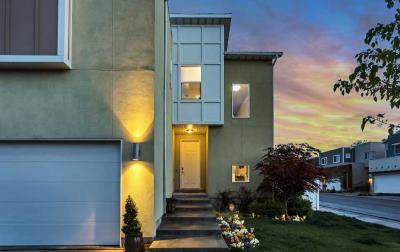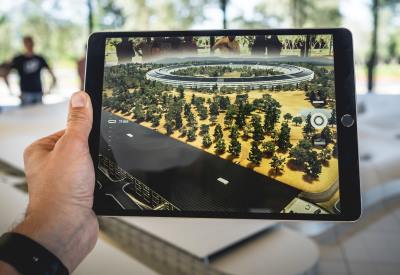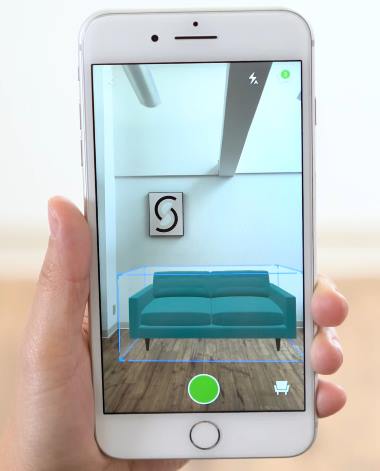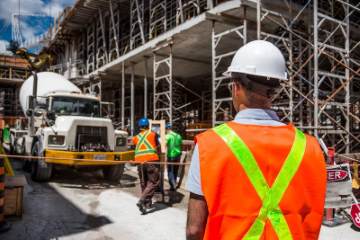
Augmented reality is a diverse technology that is revolutionizing many fields and I believe real estate marketing is next! It has the ability to make construction as well as buying and selling of real estate more convenient, quicker and cheaper for all parties involved.
In this article, I will be telling you about how exactly the real estate market can reap the benefits of augmented reality. Feel free to use table of contents below to quickly navigate to specific section that might be of interest to you.
Hassles of Buying & Selling Real Estate
Imagine you’re wanting to buy a new place. The realtor takes you to the property, but the house is still unfinished, so you’re having a really hard time imagining this place as a home. Or, let’s say you’re running on a busy schedule and are having trouble finding a suitable time (for all parties involved) to go to the house viewing. Hassles like these are oh-so-common for anybody how has gone through the process of buying or selling real estate on their own.
Well, I’m pleased to tell you that these are problems that augmented reality can help with. These reasons and more are why augmented reality has the potential to revolutionize real estate marketing. I will be explaining the possibilities of AR in real estate, as well as bringing examples of some incredibly interesting and useful apps utilizing this function.
But before diving into the nuts and bolts, let does start from some background information.
What is Augmented Reality?
First, to understand augmented reality in the context of real estate marketing, let’s quickly go over what augmented reality (AR) means. Augmented reality means that the real-world environment is enhanced by computer-generated images.

Augmented reality alters the user’s perception of the real-world environment. In the case of real estate marketing, AR is generally utilized through smartphone or tablet apps. Usually, certain digital information or objects are overlaid on real-life properties to enhance your perception of the real estate object.
As the apps can be accessed through a tablet or a smartphone, which people use every day anyway, they are very convenient. The apps run on AR platforms, some of the most popular ones being ARCore, ARKit and Lens Studio (by Google, Apple and Snapchat respectively). But I will talk about the nifty AR real estate apps out there more in-depth later.
3D Objects Placed In Your Future House
A major way in which augmented reality can be applied in the real estate field is through creating 3D visualizations of objects. According to Venturebeat, a challenge that realtors face is being able to express what the property could be, instead of what it currently is. This is where AR comes in – it creates 3D visualizations and places them in the existing property.

Let’s say, for example, that you are being given a tour of a property, but it’s all empty rooms with grey walls. Well, AR helps you imagine a completely different picture – it can replace the sad plain walls with a lovely wallpaper or place a sofa in the empty living room. Thanks to this, the client is able to get a better picture of what the property would look like finished, without having to physically stage the space.
This kind of augmented reality visualization is also extremely handy in the way that moving objects or changing up styles is very easy, as it takes no more than a few seconds.
It’s very simple and quick to create different versions of the same property, suitable to the taste and needs of each specific buyer. This method can save realtors plenty of time and money while making it very comfortable for clients.
The recent capability of AR object persistence is of great help when dealing with 3D visualizations. Until recently, digital images in augmented reality would only last for the session. Now, however, they are persistent, meaning that objects stay where they are put.
Thanks to the object persistence, the digital information can be placed once and remain there, so that it could be easily loaded when necessary. This means that the set-ups of rooms can conveniently be reloaded.
Apps For Real Estate 3D Object Visualization
Curate by Sotheby’s International Realty
An example of this type of 3D visualization app comes from Sotheby’s International Realty. It lets the user stage a room using augmented reality. The app offers many ready-made layouts for rooms in different styles.
For example, if you’re wanting to visualize an office, you can choose between a traditional or a modern office. Curate also has links to the retailer for every item – the user can easily purchase an item they like so they can use it to decorate their actual house.
According to John Passerini, the vice president of interactive marketing at Sotheby’s, AR could potentially save brokers thousands of dollars, as it means no longer having to physically stage a space.
View in My Room 3D by Houzz
Houzz is a home remodeling and decor website, whose app features the option to view 3D virtual furniture items placed in the user’s home. The app makes home decorating comfortable and easy.
Pandora Reality
Pandora Reality’s app overlays information and 3D objects on architectural models. Architectural models are often used in real estate marketing, but they have many drawbacks – they are expensive and time-consuming to build, difficult to transport and replicate, and display limited information.
Augmented reality makes this process easier and cheaper. For example, this app makes it possible to take an architectural model of a new building and then create a 3D hologram-like image of the model. It is also possible to “walk” in the 3D model by holding your phone or tablet and looking around the estate.
Tour Open Houses with the Help of AR

Augmented reality can also enhance open houses – by enabling self-guided tours for them. It could often happen that the real estate agent is not available at the time suitable for the client. Thanks to AR, the client can now easily get the necessary information about the property, even if the agent can’t be present in person.
As Sundar Siva told Venturebeat, the use of AR for open houses would allow the agents to drop content about the property onto certain areas of the house. This content could either be images, videos or interactive content like self-guided tours.
Using AR for open houses would mean that the buyer is able to tour the home at a time convenient to them, customize it to their liking and receive information about the place. The agent does not have to travel out to the property or repeat the same information for every potential buyer.
An app for this hasn’t currently been released, but you can see how it would work in this short demo below.
Information About Properties on the go
Have you ever seen a great house while walking down the street and wondered if it’s for sale? Well, augmented reality can help with this. The person can point their smartphone camera at the property and immediately get information about the price and build date, among other information.
For example, let’s say a young couple with a child is walking down the street and suddenly note an apartment building that seems perfect for them. It’s in the perfect neighborhood, a modern building – looks promising. Using the AR app, they can immediately receive information about available listings in this building instead of having to go through listings online. This is great because as we know, comfort is key these days.
Apps for Checking Out Real Estate as You Encounter them
Realtor.com Street Peek
This app allows you to find out information about properties while walking around town. All you have to do is point the phone camera at the property and you will get an overview of the number of bedrooms and bathrooms, price and more. The app also allows you to learn more about the neighborhood.
HomeSpotter
This app works in a similar way. All it takes is the camera of your smartphone and voila, the information about properties for sale appears. Distance from you to the property, price, number of bedrooms and bathrooms, and square feet are all displayed.
AR Making the Work of Construction Workers easier
We’ve seen how augmented reality can be put into good use by realtors and clients, but what about “behind the scenes”? Well, turns out AR can also be very useful for construction. If you would like to know about the topic in more detail, feel free to read my previous article about the benefits of AR in the construction industry.

AR’s capabilities to overlay information on top of real-time sites comes in very handy when dealing with something as detailed and precise as construction work. I will mention some handy apps that already exist in the current day, though there is also further potential for how AR could be of help in construction.
Supersuperagency discussed the potential of construction workers being able to use AR for visualizing the plan of city electricity and sewage pipes plan. They also mention the potential of being able to visualize electricity plans of rooms to avoid unnecessary drilling and to save time.
However, there is still work to be done to achieve this, so for the time being, it remains in the future. Now, onto the clever apps already available.
AR Apps for the Construction Industry
Safety Compass
Using augmented reality, the Safety Compass app provides “real-time safety in your pocket”. The app provides critical site information with live data and notifications warning the user of surrounding hazards. In-depth safety information can also be pulled up in the swipe of a finger, making it extremely useful for people working construction, as well as for those working in mining and manufacturing.
Astralink
The app is still in its demo phase, but it has great potential in the construction industry. Essentially, it connects 3D blueprints with the real-life construction site. Coordinating this 3D information with real-life construction without AR can be difficult and may lead to many costly mistakes.
This is why the augmented reality solution of visualizing the 3D information on top of the real-life site is extremely useful, as it can help prevent these mistakes and save money.
AirMeasure
The AirMeasure app is essentially like a digital ruler that lets the user measure real-life elements. It can be used to measure objects, rooms and to calculate whether something would fit in a space.
Using AR to Sell Haunted Properties
I think it’s safe to say we now realize the extent of the practicality of AR in real estate. However, some companies have used augmented reality in real estate marketing in a rather clever way. A prime example of this coming from the apps developer Spacious, who have a real-estate app for haunted properties. Yep, you heard me right.

The app was developed in response to the haunted apartments and houses, which are believed to have bad Feng Shui in Greater China. Therefore, the property would sell or rent for a substantially discounted price.
The app provides information on the potentially haunted locations. It is very useful, as the people who believe in ghosts can avoid them, and the property hunters who don’t believe in ghosts can score a discount.
When a user is near a haunted location, the interface will show ghosts, alongside apartment listing information. It’s also possible to chase the ghosts around town and catch them, similarly to Pokemon Go.
Future Potential
The future for augmented reality in real estate looks promising. Digi-capital predicts that Mobile AR could become the primary driver of a $108 billion VR/AR market by 2021 with AR taking up $83 billion.
And as it turns out, the public is quite receptive to the idea of augmented reality and virtual reality in real estate. Bank of America reports that at least 36% of homebuyers would attend an open house using virtual or augmented reality. Though the use of AR in real estate is still a fairly recent phenomenon, it seems that people are taking to it quite fast. Well, how could you not, with all the awesome solutions already out there?
The nifty apps I mentioned are a great example of the potential of AR being realized in the real estate field. Hopefully, as time goes by, more realtors and clients alike will start seeing and utilizing the opportunities that AR in the real estate field provides.
